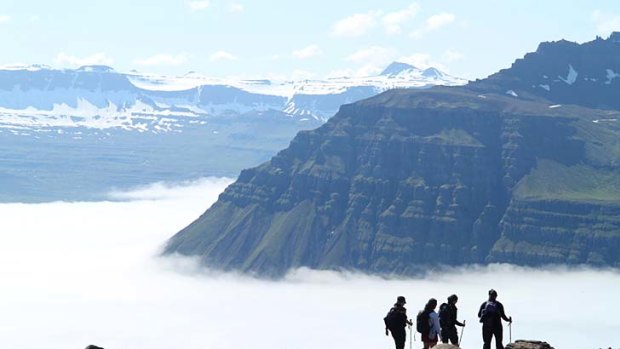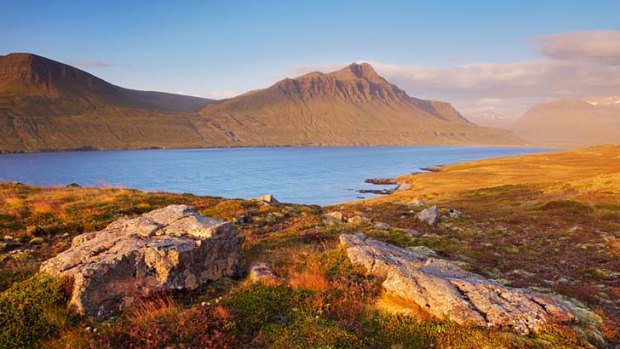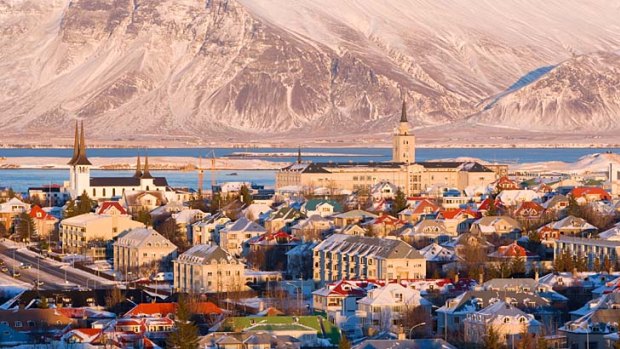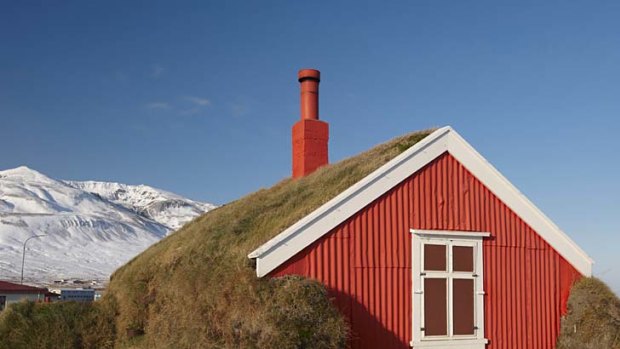
Panoramic ... walkers explore the Icelandic wilderness.Credit: Richard Tulloch
Where wild, hard men once lived, Richard Tulloch relishes the deafening silence.
'Stop a moment, Richard," Rob says. "You hear it?"
We're the photographers in the party. On yet another high col we've lagged behind our hiking group to take yet more panoramic shots. My boots crunch to a halt. I listen.

A typical fiord with a mountain backdrop.Credit: Alamy
"Hear what?" I ask.
"The silence."
For the first time I notice it. No murmur of traffic, no hum of a town in a distant valley. There's not a blade of grass and not a breath of wind to rustle it. It's impossible to imagine a deeper silence. It has probably been there at other times during the days we've been walking, but I was distracted by the scenery.

Reykjavik, the capital of Iceland, in winter.Credit: Alamy
Iceland is emerging from a long, cold spring, so the slopes are broken by patches of snow and cut by countless streams, tumbling as waterfalls from the crags, spreading over the lower reaches in tiny rivulets, nourishing slushy lime-green mosses and bright flowering shrubs.
The corner of the country known as the Viknaslodir region has been spewed out of volcanos and ground by glaciers, then buried under metres of snow. The mountain peaks are jagged lava outcrops and the stones on their shoulders are split and shattered, too recently in geological time for water to have softened their sharp edges.
Below us are the fiords, blanketed by mist in the mornings, then emerging impossibly blue as the sun burns it off. Their deserted beaches are of black sand and the water pouring into them is clear, icy and "the cleanest in the world" we're proudly told. Often.

One of the huts where trekkers can rest.Credit: Getty Images
In more accessible parts of the planet, somewhere as spectacular as this would have tourists pouring from buses, a cafe perched on the spot we're standing and gondolas bringing visitors and their cameras up the mountain. But we've gone days without seeing another human being. That's partly because it's not so easy to get here.
Our walk was billed as "Hiking at the End of the World". Iceland itself is remote and its far north-east is isolated even by Icelandic standards, with the Norwegian Sea on one side and thousands of square kilometres of untouched wilderness on the other.
The capital Reykjavik is a regular stopover for US travellers bound for destinations further east, or heading home afterwards.
An American friend told me he'd been to Iceland three times but never ventured out of the airport's transit lounge.
I can understand why. It's a good distance into town and the initial impression when you arrive is that there's not much to see and do.
Reykjavik (city population about 120,000) reminded me of Queenstown in New Zealand - a lively place, but one backpackers pass through on the way to somewhere even more exciting.
Shops were selling adrenalin-pumping adventure tours or gear to wear while playing outside. Cafes sold pizzas and pasta. Excellent coffee was a bonus; Kaffitar claimed to have been well placed in a recent European barista championship and has developed into an Icelandic chain business.
Many restaurants offered thrill-seeking tourists servings of minke whale steaks. Yes, we tried one, for purely scientific research purposes, three of us sharing a small portion of the dark meat. I can now reveal that the world would still be a happy place if nobody ever again ate a whale - it's tough chewing, not particularly tasty and you're likely to choke as your principles resist swallowing.
Some places offered puffin dishes as well. I drew the line at that. Puffins may not be endangered, but they are cute.
On the morning I was supposed to fly across the country to start this hiking trip, a shuttle bus had been booked to pick me up from the hotel at an ungodly early morning hour. It arrived five minutes before my plane was scheduled to take off.
"I've missed it, haven't I?" I asked the driver.
"We will see about that," he shrugged, backing into a kerbside tub of flowers and taking off with a screech of tyres. We were at the domestic airport three minutes later - really. I ran into the terminal to find ground staff holding open the door to the tarmac. I dived into the small plane. No ticket, no boarding pass, no security.
I'd expected things in Iceland to run efficiently, but instead usually found friendly chaos. "We learned it from the Irish," a smiling Icelander told me. In the old days, Vikings raided Ireland and brought back slaves and wives.
There are similarities in their recent history, too. A century ago both Ireland and Iceland were poor, cold, wet and miserable, under the thumbs of their respective English and Danish rulers. Then came independence and boom years, followed by money and scams.
Property prices soared, bank borrowing skyrocketed and then it all caved in. The collapse of the Icelandic banking system was an early sign that a global financial crisis was on its way.
There were no signs of such troubles when our plane landed in Egisstadir and we met our fellow trekkers. There were eight of us, Portuguese, British, American, Swiss and Australian, age range 30-ish to 60-ish, and two Icelandic guides, Inga and Jon. A minibus with very thick tyres brought us up a mountain, dropped us off and drove away.
From there we walked, for five days. We covered a modest 65 kilometres horizontally and climbed and descended a creditable 3500 metres vertically. We edged along steep snowfields, clambered over scree and forded or rock-hopped across dozens of those streams.
It was an adventure, sometimes physically challenging, but as we agreed, it always felt safe. No thunderstorms, no precipices, no snakes, "and no grizzly bears", observed Alex, who'd just been hiking in Canada.
Though we were all experienced walkers, we were grateful to have local guides. Our route was generally well marked but on occasions required tramping over trackless mountain cols with fog closing in. When the weather cleared, our navigator Inga was able to lead us across country and over the highest peak in the area, the 770-metre Hvitserkur (White Mountain).
Inga, a qualified biologist as well as a mountain guide "trained to New Zealand standards", promised us a good chance of meeting reindeer on the high slopes. We found tracks but they must have flown off to help Santa when they saw us coming. Birds were everywhere, though, with gulls breeding in cliff colonies and plovers and whimbrels whistling warnings.
Jon, large and blond, was a native of east Iceland and a true Viking. He proved incredibly sure-footed on the rough terrain and when needed his heavy boots stamped massive footholds in the snow for us to follow.
When Jo slipped on a steep slope, Jon magically appeared below her to halt her slide. None of us believed a big man could move so fast. "Since I was 10-year-old boy I help my father catch sheeps on the mountain. Sheeps run fast, too."
He showed us the ruins of abandoned farmhouses, where turf covered the walls to keep out the cold. Life was hard in this region. Early last century few Icelanders had seen water flowing from a tap.
We enjoyed the tea Jon made from wild thyme and tasted the black crowberries he collected. Not bad, but fortunately we weren't relying on them for survival. A four-wheel-drive vehicle arrived ahead of us each evening, dropping our luggage and food for our dinner at a hut.
The huts operated by the Icelandic Touring Association were new, basic and communal; bunk beds in dormitories and gas stoves. Some had hot showers, some didn't. There was seldom mobile phone coverage.
We ate well. Inga proved a dab hand at chucking a salmon on the barbie and Jon's Icelandic lamb goulash was a revelation. The rest of us chipped in with our specialities - Alex's New York salad dressing and the Portuguese vegetables were highlights.
After five days on the trail we were sleep-deprived, partly due to the communal sleeping arrangements, partly because of the midnight sun. Though our legs had had a good workout from walking six to eight hours each day, we were not exhausted. We wanted the adventure to go on, but the bus was waiting for us in the valley far below.
"Better get down there," Rob says, "and find out what's happening in the world." We pack the cameras away and start down the hill.
Detecting the movement, the GPS computer on my wrist switches itself on with a tiny peep. It is a sound so faint that I usually don't hear it. In the silence of the Viknaslodir mountains it's as clear as a bell.
The writer was the guest of Fifty Degrees North.
Three other Iceland adventures
1 Hiking the Laugavegur region The trek in the volcanic area past Eyjafjallajokull (the one that caused all the trouble by erupting in 2010) is the most popular in Iceland. Five-day vehicle-assisted trek from $1230. fiftydegreesnorth.com.
2 Walking on glaciers Iceland's biggest glaciers are easy to reach from Reykjavik for a day or overnight tour. Beginners get instruction on using crampons. From 19,900 krona ($158). mountainguides.is.
3 Whale watching Numerous boat tours will take visitors out to see them alive and frolicking, rather than on a restaurant plate. icewhale.is.
Trip notes
Getting there
Etihad flies from Sydney to London. travel.com.au. Icelandair flies from London to Reykjavik return from £263 ($421) return. icelandair.com.
Hiking there
50 Degrees North organises five-day hiking tours in Viknaslodir. Cost from $1390 includes guides, transport to start of walk, all luggage transfers, accommodation and meals. 1300 422 821, fiftydegreesnorth.com.
Staying there
Tent camping on the route is possible and huts can be booked independently. Cost 4500 krona ($36) a person a night. Independent walkers need to carry in their own food and sleeping bags. See www.fi.is.
Need to know
The route is normally only passable by hikers without technical mountaineering skills between July and September. At any time of year a good level of fitness and wet weather clothing and footwear are required.
Sign up for the Traveller Deals newsletter
Get exclusive travel deals delivered straight to your inbox. Sign up now.